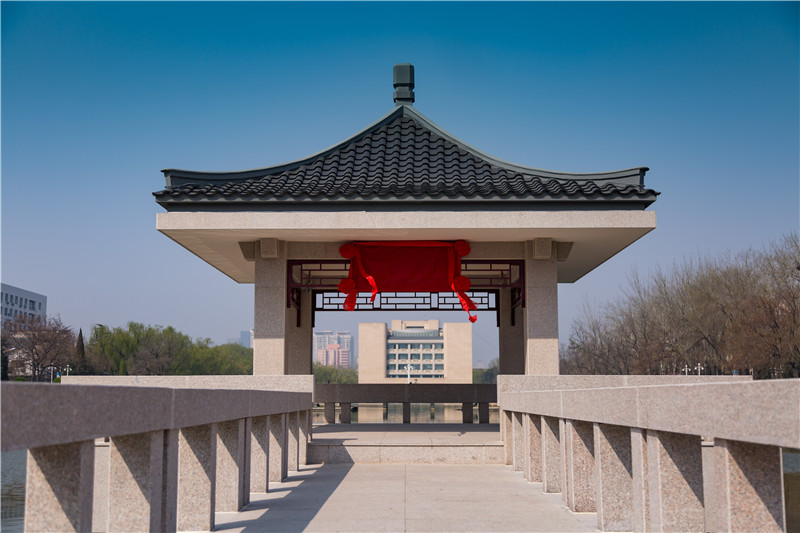Qiushi Pavilion

Between the water and the sky, there lies a stout and simple cement "pavilion" with gray tiles above the Jingye Lake of Weijin RoadCampus of Tianjin University. This is one of the landmark buildings of Tianjin University—Qiushi Pavilion (Qiushi means seeking truth).
This simple“pavilion”was built at the same time as the construction of Peiyang Square in 1984. It is called“Qiushi Pavilion”because of the plaque "Seeking truth from facts" donated by the Shaanxi Alumni Association during the 90th anniversary of TJU.
In traditional Chinese architecture, “pavilion” refers to carved beams and painted ridges, representing elegance and beauty. Academician Peng Yigang, a master architect in China and professor of Tianjin University, didn’t follow the traditional approach of building the pavilion in an archaistic, elegant and magnificent way when he started the design of the“pavilion”. Instead, with the integration of the University’s cultural background and surrounding environment, he took reinforced concrete as the main structure and designed an unpretentious-style pavilion that correspond with TJUers’ unassuming grace. He believed that the style of traditional gardens in Northern China was not compatible with the overall environment of the campus andwithlimited funds, he designed a new“Chinese-style”reinforced concrete pavilion.
The top of the pavilion has been designed in a curved shape, and the tiles on the pavilion were old ones removed from the top of another building on campus when it was under overhaul. In the period of construction, he often went to the site and constantly perfected his previous design ideas according to the schedule of construction. Traditional mahogany-headed pillars were replaced by stout concrete square pillars, and the upturned‘flying eaves’became‘flat eaves’. Withoutcolored glaze, the graytiles on the pavilionretain their graceful charm. In addition,“flat eaves”above the square pillars aresolidand robust. There is noclassical and traditional mahogany, no levityofupward "flying eaves", but instead, there are resilient square columns and grey tiles as well as unadorned elegance, making the pavilion, lake, road and the buildings bring out the best in each other.
Qiushi pavilion isaconcrete embodiment of inclusive and integrated development of TJU. The beauty of the classical Chinese pavilion meets with thestyle and spiritof TJU. In the heart of the quiet lake, the spring water ripples with the beautiful campus, and also ripples with the lofty aspirations and the character of the lofty Tianjin University. This simple, solemn and innovative “Qiushi Pavilion” is exactly an embodiment of the spirit of "Seeking Truth from Facts" of all TJUers.
Generations of students read in the pavilion with the sunrise, and stroll in it at dusk, appreciating the autumn water growing in the samehueas the sky and the sunset and solitary ducks flying together. Broken ice takes away the silence of winter, ushering in the spring gurgling sound. Crabapple petals flutters along the running water for the autumn peace. Fallen leaves cover the pavilion, followed by a snow. The sky, clouds, the pavilion and water are dressed up in white as a whole. The only shadow on the lake, is the pavilion in which two or three people sit. Timewitnessesleisurely rotations of the four seasons. The sky is clear after the rainbow decorated pavilion with pure white. The rain at that night slowly dripping down along the“flat roofs”. Through the curtains of the rain, you can see the most stunning rosy clouds, plating the hanging plaque with gold edges, on which the motto "seeking truth from facts" in the sunlight glitters.
People in Tianjin University are down-to-earth, good at exploring, striving for excellence, and determined to innovate. This heart in the water is actually a dashing greatness of character that washes eyes, and even more the hearts.
In October 2016, Tianjin University renovated and rebuilt“Qiushi Pavilion”on the basis of its original appearance. The brand-new steel and concrete disturbed not only the lake, but also the deepest memories and attachment in the hearts of the teachers and students of Tianjin University. They were afraid that this small pavilion, which carried the memories of several generations of TJUers, would lose its original fortune. During the reconstruction, Peng came to the site many times and polished his ideas together with the young designers responsible for the restoration. As time passes, the new and old TJU designers in the construction of the Qiushi Pavilion demonstrated righteousness and innovation, seeking truth from facts, and striving for effectiveness and shrewdness, which is precisely silent inheritance to the Tianjin University motto of Seeking Truth from Facts. After the reconstruction of the Qiushi Pavilion, the people of Tianjin University were reunited when crabapple flowers are fragrant. It is majestic and magnificent, with its style remaining the same. Within sight, it is the reversal of the lost youth and the gentle past. Dedicated to innovation, Tianjin University is forever young.
Standing on the central axis of the University,“Qiushi Pavilion”stands erectly without words, announcing to the world that seeking truth from facts has been internalized as the spiritual character of Tianjin University, guiding generations of students to seek truth and pragmatism and search with their will unbending so that they can possess the spirit of "earnestlytransforming Chinain practiceinstead ofindulgingin empty talk on paper".
By: Zhang Yifan
Editor: Sun Xiaofang

